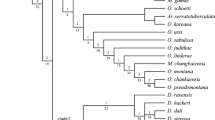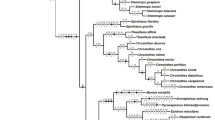Abstract
Rhinocricus Karsch, 1881 has 207 species occurring mainly in the Americas, and more than 60 of them were described from Brazil. The genus was proposed based on the presence of dorsal scobinae on the prozonites. The present study evaluates the monophyly of three species groups previously proposed in Rhinocricus. We evaluated 39 morphological characters and included 30 species as terminal taxa, 9 of which are outgroups. We performed a parsimony analysis under implied weighting in TNT 1.5, obtaining the same most parsimonious tree topology with three optimal K values (5.992, 7.309, and 9.105). None of the three previously proposed species groups of Rhinocricus was recovered monophyletic. Rhinocricus (Erythocricus) sanguineostriatus Schubart, 1962 was recovered sister to all other species, and Argentocricus Verhoeff, 1941 resulted paraphyletic. The diagnostic morphological characters traditionally used to separate species groups, subgenera, and genera were not recovered as synapomorphies. Further investigation including a broader species sample is needed to establish robust relationship hypotheses between Argentocricus and the remainder species of Rhinocricus, thus identifying monophyletic groups in the genus and their synapomorphies.





























Similar content being viewed by others
References
Attems, C. G. (1943). Myriopoden von Brasilien gesammelt von E. Bresslau in den Jahren 1913/14. Senckenbergiana biologica, 26, 434–458.
Brölemann, H. W. (1901). Myriapodes du Musee de Sao Paolo. Revista Museu Paulista, 5, 1–10.
Brölemann, H. W. (1913). Un noveau système des Spirobolides [Myriapoda. Diplopoda]. Bulletin de la Société Entomologique de France, 19, 476–478.
Brolemann, H. W. (1929). Myriapodes recueillis au Bresil par M. le Professeur Caullery, Membre de l'Institut. Mémoires de la Société Zoologique de France, 29, 1–37.
Bueno-Villegas, J., Sierwald, P., & Bond, J. E. (2004). Diplopoda. In J. L. Bouquets & J. J. Morrone (Eds.), Biodiversidad, taxonomía y biogeografia de Artrópodos de México vol. IV (pp. 569–599). Universidad Nacional Autonoma de México.
Enghoff, E., Golovatch, S. I., Short, M., Stoev, P., & Wesener, T. (2015). Diplopoda—taxonomic overview. In A. Minelli (Ed.), Treatise on zoology—anatomy, taxonomy, biology. The Myriapoda (Vol. 2, pp. 363–455). Leiden, Boston: Brill.
Enghoff, E. (2015). Diplopoda—geographical distribution. In A. Minelli (Ed.), Treatise on zoology—anatomy, taxonomy, biology. The Myriapoda (Vol. 2, pp. 329–336). Leiden, Boston: Brill.
Fontanetti, C. S., & Camargo-Mathias, M. I. (2004). External morphology of the antennae of Rhinocricuspadbergi Verhoeff, 1938 (Diplopoda, Spirobolida). Brazilian Journal of Morphological Sciences, 21, 73–79.
Goloboff, P. A. (1993). Estimating character weights during tree search. Cladistics, 9, 83–91. https://doi.org/10.1111/j.1096-0031.1993.tb00209.x.
Goloboff, P. A., & Farris, J. S. (2001). Methods for quick consensus estimation. Cladistics, 17, 26–34. https://doi.org/10.1111/j.1096-0031.2008.00217.x.
Goloboff, P. A., Farris, J. S., & Nixon, K. C. (2008). TNT, a free program for phylogenetic analysis. Cladistics, 24, 774–786. https://doi.org/10.1111/j.1096-0031.2008.00217.x.
Golovatch, S. I., & Kime, R. D. (2009). Millipede (Diplopoda) distributions: a review. Soil Organisms, 81, 565–597.
Golovatch, S. I. (2014). On some new or poorly-known millipedes from Chile and Argentina (Diplopoda). Russian Entomological Journal, 23, 249–281.
Hoffman, R. L. (1960). Millipeds from Dominica, British West Indies. Proceedings of the United States National Museum, 111, 33–41.
Hoffman, R. L. (1980a). Studies on spiroboloid millipeds. XI. On the status of Spirobolus nattereri Humbert & DeSaussure, 1870, and some species traditionally associated with it (Rhinocricidae). Papeis Avulsos de Zoologia, 33, 177–181.
Hoffman, R. L. (1980b). Classification of the Diplopoda. Muséum d’Historie Naturelle.
Hoffman, R. L. (1999). Checklist of the millipedes of North and Middle America, Virginia Museum of Natural History Special Publication. No, 8. Virginia: Virginia Museum of Natural History.
Hoffman, R. L & Golovatch, S. I. (2012). The millipede genus Argentocricus Verhoeff, 1941 (Diplopoda, Spirobolida, Rhinocricidae). Arthropoda Selecta, 21 (3), 211-215.
Karsch, F. (1881). Neue Juliden des Berliner Museums, als Prodromus einer Juliden-Monographie. Zeitschrift für die Gesammten Naturwissenschaften. Leipzig, Stuttgart, 54, 1–78.
Koch, M. (2015). Diplopoda—general morphology. In A. Minelli (Ed.), Treatise on zoology—anatomy, taxonomy, biology. The Myriapoda (Vol. 2, pp. 7–67). Leiden, Boston: Brill.
Marek, P. E., Bond, J. E., & Sierwald, P. (2003). Rhinocricidae systematics II: a species catalog of the Rhinocricidae (Diplopoda: Spirobolida) with synonymies. Zootaxa, 308, 1–108.
Maddison, W. P. & Maddison, D. R. (2017). Mesquite: a modular system for evolutionary analysis. Version 3.2 http://mesquiteproject.org..
Mirande, J. M. (2009). Weighted parsimony phylogeny of the family Characidae (Teleostei: Characiformes). Cladistics, 25, 574–613.
Nixon, K. C. (2002). WinClada, version 1.00.08. Published by the author, Ithaca, New York. http://www.cladistics.com.
Pitz, K. M., & Sierwald, P. (2010). Phylogeny of the millipede order Spirobolida (Arthropoda: Diplopoda: Helminthomorpha). Cladistics, 26, 497–525.
Pocock, R. I. (1894). Contributions to our knowledge of the arthropod fauna of the West-Indies. Journal of the Linnean Society of London, 24, 473–544.
Rodrigues, P. E. S., Ott, R., & Rodrigues, E. N. L. (2012). New species and new records of millipedes of the genus Rhinocricus Karsch, 1881 (Spirobolida: Rhinocricidae) from southern Brazil. Zootaxa, 3172, 55–64.
Rodrigues, P. E. S., Rodrigues, E. N. L & Ott, R. (2018). Four new species of Rhinocricus (Diplopoda: Spirobolida: Rhinocricidae) from Brazil. Iheringia, Série Zoologia, 108, 1–5. doi:https://doi.org/10.1590/1678-4766e2018031.
Schubart, O. (1944). Os Diplopodos do Pirassununga. Acta Zoologica Lilloana, 2, 321–440.
Schubart, O. (1949). Os Diplopoda de algumas ilhas do litoral Paulista. Memorias do Instituto Butantan, 21, 203–254.
Schubart, O. (1951). Contribuição para a fauna do estado de São Paulo. II. Os Rhinocricidae (Opisthospermophora, Diplopoda). Anais da Academia Brasileira de Ciências, 23, 221–275.
Schubart, O. (1962a). Um novo gênero da Família Rhinocricidae da Bahia (Opisthospermophora, Diplopoda). Anais da Academia Brasileira de Ciências, 34, 265–268.
Schubart, O. (1962b). Novas espécies brasileiras da Família Rhinocricidae (Diplopoda, Opisthospermophora). Anais da Academia Brasileira de Ciências, 34, 69–87.
Velez, M. J. (1962). A new genus (Orthocricus) of the family Rhinocricidae (Diplopoda: Spirobolida). Caribbean Journal of Science, 3, 209–211.
Verhoeff, K. W. (1938). Über einige amerikanische Myriapoden. Zoologischer Anzeiger, Leipzig, 122, 273–284.
Verhoeff, K. W. (1941). Über Spirostreptiden Südamerikas, vergleichende Morphologie und Mechanik der Gonopoden und eine neue Rhinocriciden-Gattung. Archiv für Naturgeschichte, 10, 278–302.
Wesener, T., Enghoff, H., & Wagele, J. W. (2008). Pachybolini—a tribe of giant Afrotropical millipedes: arguments for monophyly and the description of a new genus from Madagascar (Diplopoda: Spirobolida: Pachybolidae). Invertebrates Systematics, 22, 37–53.
Acknowledgments
We thank Sergei Golovatch and an anonymous reviewer for valuable comments and corrections on this paper. We also thank Ricardo Pinto-da-Rocha for providing access to the type material and to the technician Mauro Cardoso Júnior for all assistance in the Museu de Zoologia (MZSP).
Funding
This study was partially supported by the Coordenação de Aperfeiçoamento de Pessoal de Nível Superior - Brasil (CAPES), Finance Code 001 (P.E.S. Rodrigues-88887.178957/2018-00).
Author information
Authors and Affiliations
Corresponding author
Additional information
Publisher’s note
Springer Nature remains neutral with regard to jurisdictional claims in published maps and institutional affiliations.
Rights and permissions
About this article
Cite this article
Rodrigues, P.E., Campos, L.A., Ott, R. et al. Phylogeny of three species groups of Rhinocricus Karsch, 1881 based on morphological characters (Diplopoda, Spirobolida, Rhinocricidae). Org Divers Evol 20, 141–153 (2020). https://doi.org/10.1007/s13127-019-00421-3
Received:
Accepted:
Published:
Issue Date:
DOI: https://doi.org/10.1007/s13127-019-00421-3




